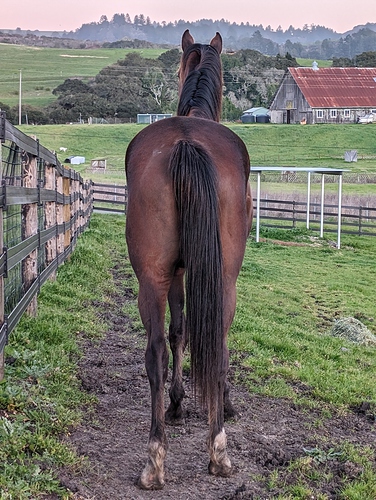I’m in a position almost ALL horse people find themselves in: the horse is “not quite right” - not outright lame/unsound, but definitely a little off. Not off enough to avoid riding per the vet. Because of this, we run into issues that can be written off as training issues (heavy on the forehand, rushing to/from jumps at certain gaits, bucking at certain gaits, etc.).
So, we shell out the money for diagnostics and treatment. But when we think we’ve found and treated the cause, we don’t see any quick improvement with the training issues despite hearing “you should see an improvement in X amount of time.”
I’m right at the step where I shell out the money for diagnostics and treatment. But I’m hesitant - after working with a chiro and incorporating improved diet and specific exercise plan, I truly think my horse has made improvements (muscularity and postural-y). Yet, we still sometimes have those “training” issues. Granted, it hasn’t been but less than 1/4 of a year since I’ve started down this path. I’m worried that if I do spend the money on the diagnostics and treatment, I’ll still be where I am right now.
At what point does the “pre-habilitation” stop working? Is it unfair to assume that horses are bit like humans when it comes to addressing a biomechanics issue? I know my conformation for running is not great - I’ve got two knock knees. But with appropriate cross training, properly fitting equipment, and mindfulness of my form, when I run, I don’t feel pain. I’m not at the age or pain level where steroid injections or advanced medical treatments are typical (I’ve been above average active all my life, but am by no means a body builder or marathon runner), and neither is my horse.
I guess what I’m asking here is - at what point do we decide our “not quite right” horses we’ve been carefully training and stretching and adjusting need the high-cost diagnostics and injections/corrective treatments?
I come from having a horse as a kid 15 years ago, and I feel like there’s so much more to equine performance now-a-days. In between then and now, I was lessoning and leasing school horses. I’m so new to this world of equine sports medicine and what’s training-related and what’s a quirk and what’s true pain. It feels like we can almost always find SOMETHING with every horse, and we as horse owners always try to do the best for our animals. With everything out there now, it almost seems like riding the horse isn’t a viable option for any of them!


 She was totally sound at the walk, and 2/5 lame on the LH at the trot, only when trotting slowly. I don’t have any after photos, but her spine and pelvis are about 90% improved 4 months later and she’s totally sound. She had a full vetting with clean x-rays and good flexions at the end of February, so I know there’s nothing going on that I can’t see. It took a few massages and 4-5 chiro/acupuncture appointments over 3.5 months to get her fixed, and it wasn’t cheap, but it was way cheaper than going full on diagnostics. I think she’s a great example because she’s young and had a fresh PPE so I know that the misalignment caused the lameness. How she got that way, who knows… she’s 3.
She was totally sound at the walk, and 2/5 lame on the LH at the trot, only when trotting slowly. I don’t have any after photos, but her spine and pelvis are about 90% improved 4 months later and she’s totally sound. She had a full vetting with clean x-rays and good flexions at the end of February, so I know there’s nothing going on that I can’t see. It took a few massages and 4-5 chiro/acupuncture appointments over 3.5 months to get her fixed, and it wasn’t cheap, but it was way cheaper than going full on diagnostics. I think she’s a great example because she’s young and had a fresh PPE so I know that the misalignment caused the lameness. How she got that way, who knows… she’s 3. 